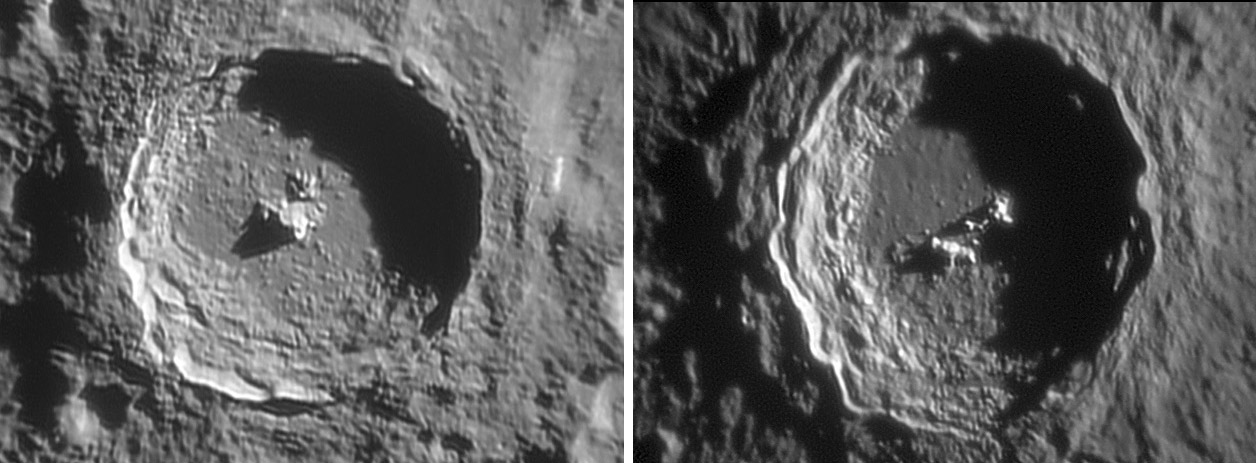|
|
| (4 intermediate revisions by the same user not shown) |
| Line 1: |
Line 1: |
| | __NOTOC__ | | __NOTOC__ |
| | =Two Young Ones= | | =Two Young Ones= |
| | + | <!-- Start of content --> |
| | <div class="post" id="post-1149"> | | <div class="post" id="post-1149"> |
| | | | |
| Line 6: |
Line 7: |
| | <p>[[File:Cop_tycho-LPOD.jpg|Cop_tycho-LPOD.jpg]]<br /> | | <p>[[File:Cop_tycho-LPOD.jpg|Cop_tycho-LPOD.jpg]]<br /> |
| | <em>images by [mailto:MSalway@hutchison.com.au Mike Salway], Australia</em></p> | | <em>images by [mailto:MSalway@hutchison.com.au Mike Salway], Australia</em></p> |
| − | <p>Craters have a family resemblence, but their relationship is based on physics not blood. The impact process is a complex balance of forces, with the energy of impact working against the force of gravity and the bond strength of rocks. For craters with diameters larger than about 30 km the tremendous kinetic energy of impact largely overwhelms variations due to target characteristics, and large craters look pretty much alike. Thus, 85 km wide Tycho (left) is very similar to 93 km wide Copernicus (right). Each crater has a sharp scarp at the inner summit of the surrounding rim mound. Below the scarp is a series of circular mountain ranges or terraces that step down from the rim to the crater floor. The rounded tops of the terraces result from them being crumpled as they were downdropped. Large craters like these have relatively flat floors with central mountains that are rebounds from the impact. Both Tycho and Copernicus have multiple peaks. It is unclear why peaks are often elongated or are off-center (could they be oblique impacts?). Crater floors have roughness from fallback debris and smooth areas that are impact melt. For Tycho these smooth and rough areas are seemly random but the melt is concentrated in the [http://www.lpod.org/archive/archive/2004/02/LPOD-2004-02-13.htm northwest quadrant] of Copernicus’ floor. At this resolution, neither crater has many later impacts within it - which is strange, for Copernicus is nearly 10 times as old as Tycho (roughly 1 billion vs 100 million years). </p> | + | <p>Craters have a family resemblence, but their relationship is based on physics not blood. The impact process is a complex balance of forces, with the energy of impact working against the force of gravity and the bond strength of rocks. For craters with diameters larger than about 30 km the tremendous kinetic energy of impact largely overwhelms variations due to target characteristics, and large craters look pretty much alike. Thus, 85 km wide Tycho (left) is very similar to 93 km wide Copernicus (right). Each crater has a sharp scarp at the inner summit of the surrounding rim mound. Below the scarp is a series of circular mountain ranges or terraces that step down from the rim to the crater floor. The rounded tops of the terraces result from them being crumpled as they were downdropped. Large craters like these have relatively flat floors with central mountains that are rebounds from the impact. Both Tycho and Copernicus have multiple peaks. It is unclear why peaks are often elongated or are off-center (could they be oblique impacts?). Crater floors have roughness from fallback debris and smooth areas that are impact melt. For Tycho these smooth and rough areas are seemly random but the melt is concentrated in the [[February_13,_2004|northwest quadrant]] of Copernicus’ floor. At this resolution, neither crater has many later impacts within it - which is strange, for Copernicus is nearly 10 times as old as Tycho (roughly 1 billion vs 100 million years). </p> |
| | <p align="right"><em>Chuck Wood</em></p> | | <p align="right"><em>Chuck Wood</em></p> |
| | <p><strong>Technical Details:</strong><br /> | | <p><strong>Technical Details:</strong><br /> |
| Line 13: |
Line 14: |
| | Rükl plates 31 & 64.<br /> | | Rükl plates 31 & 64.<br /> |
| | [http://www.iceinspace.com.au Mike’s website]</p> | | [http://www.iceinspace.com.au Mike’s website]</p> |
| − | <div align="center">Don’t forget to add yourself - as I have done - to the growing list of lunatics at [http://www.lpod.org/?m=20070509 Frappr LPOD]! | + | <p><b>Yesterday's LPOD:</b> [[May 28, 2007|When Maria Are Bright]] </p> |
| − | <p><em>LPOD earns a commision when you buy ANY book from Amazon thru [[LPOD]] Have you bought a book lately?</em><div> | + | <p><b>Tomorrow's LPOD:</b> [[May 30, 2007|Two Views in One]] </p> |
| | </div> | | </div> |
| − | ---- | + | </div> |
| − | ===COMMENTS?===
| + | <p> </p> |
| − | Click on this icon [[image:PostIcon.jpg]] at the upper right to post a comment.
| + | <p> </p> |
| | + | <p> </p> |
| | + | <!-- End of content --> |
| | + | {{wiki/ArticleFooter}} |




